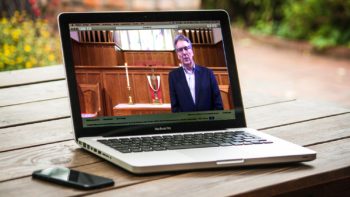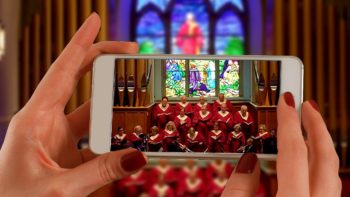What Disciples Believe
(From the 2003 Statement from Coastal Plains Area Churches)
- Open Communion
The Lord’s Supper, or Communion, is celebrated in weekly worship and it is open to all who believe in Jesus Christ.
- The Oneness of the Church
All Christians are called to be one in Christ and to seek opportunities for common witness and service.
- Freedom of Belief
As Disciples, we are called together around two essentials of faith: a belief in Jesus Christ as our Lord and Savior, and that Christians are free to follow their conscience guided by the Bible, the Holy Spirit, study, prayer, and are expected to extend that freedom to others.
- Baptism by Immersion
In baptism, the old self-centered life is set aside, washed away and a new life of trust in God begins. Although Disciples practice baptism by immersion, other baptism traditions are honored.
- The Ministry of Believers
Both ministers and lay persons lead in worship, service and spiritual growth.
- And above all that, Jesus Christ is the son of the Living God, who offers saving grace to all who seek it through His Son.
What is the Symbolism of the Red Chalice?
The Red Chalice, bearing the “X-shaped” cross of St. Andrew was adopted as the symbol of the Christian Church (Disciples of Christ) by the denomination’s General Assembly in 1971.
The chalice symbolizes the centrality of the Lord’s Supper to Disciples life. The St. Andrew’s cross, the national cross of Scotland, focuses attention on the Scottish Presbyterian roots of the church. Thomas and Alexander Campbell both studied in Scotland and were Presbyterians. St. Andrew has been identified with the laity and evangelism, prominent emphases of the Disciples over the years.
The red color of the chalice signifies vitality, spirit and sacrifice.
The Christian Church (Disciples of Christ)
The Christian Church (Disciples of Christ) was founded in the United States in 1832. Seeking to move beyond denominational disagreements, the founders envisioned a united church of Jesus Christ modeled on the New Testament. Today we are over 3,700 congregations strong and still share that vision.
The organizational structure of the Disciples of Christ is strongly congregational, in which three levels, or “manifestations” (General, Regional / Area, and Congregational), operate as equals, managing their own finances, property, and program, with strong but voluntary ties to each other. This voluntary association is expressed as being “in covenant”, with mutually-agreed commitments and obligations between the three manifestations of the church.
The nearly 4,000 local congregations have their own property and full control of their budgets and program. Likewise, the 33 Regions exercise rights within their own sphere of operation. Because of their numerical and areal size, two Regions are further divided into Areas. The Southwest Region, of which Bethany is a part, includes eight Areas; Bethany is in the Coastal Plains Area that includes Houston and surrounding areas.
The main representative body at the national / international level is the General Assembly, which meets every two years and is composed of lay and ordained voting delegates from each manifestation of the church. A General Board of 160 voting members, at least half of which are lay persons, meets annually, and a 44-member Administrative Committee, similarly lay-oriented, meets more frequently.
The chief executive officer of the Christian Church (Disciples of Christ) is called the General Minister and President. However, the General Assembly, General Board, and Administrative Committee are presided over by a Moderator who is elected for a two-year term.
More information on the Christian Church (Disciples of Christ) can be found at http://www.disciples.org.
How Do I Join the Church?
Joining Bethany is straightforward. The only requirement for membership is a confession of faith in our Lord and Savior, Jesus Christ. If you belong to another church, you can transfer your membership to Bethany. Those new to the faith will be baptized after their confession of faith.




